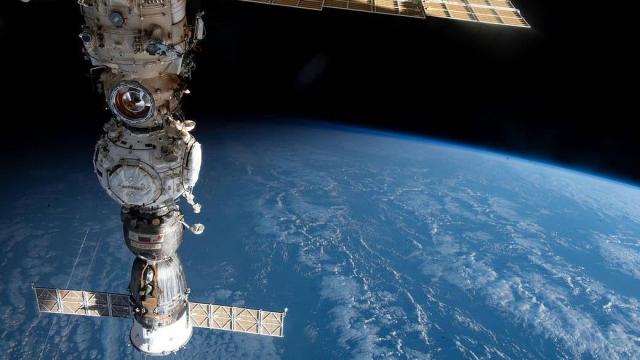The recent Progress 82 coolant leak was caused by an “external impact” and not some kind of manufacturing defect, Roscosmos is now claiming. At the same time, the Russian space agency is still having to deal with the fallout from the Soyuz MS-22 coolant leak in December, with plans to launch the replacement vehicle on Thursday.
Two Russian cosmonauts and a NASA astronaut who were originally slated to return to Earth next month will have to wait until later this year to ride aboard the Souyz MS-23, which will remain docked to the ISS to serve as a lifeboat in the event of a serious emergency. Russia recently bumped the launch to March following a similar incident with its Progress 82 freighter, but later announced through its space agency’s Telegram channel that it is now targeting launch on Friday, February 24 at 11:24 a.m. AEDT, according to Space Policy Online.
The MS-23 spacecraft was originally scheduled to launch on February 20, but the mission was postponed as a result of Progress 82 leaking out its coolant on February 11 while docked to the station. It was the second incident in as many months. The Progress 82 freighter, an expendable cargo spacecraft that arrived at the space station in October 2022, sprung a coolant leak from its external radiator.
An emergency commission was set up to look into the cause of the leak, in which Roscosmos officials examined images of the freighter obtained by Canada’s robotic arm. Progress 82 undocked from the ISS on Saturday and burned upon reentry into Earth’s atmosphere, with parts of it landing in the Pacific Ocean, Russian state media TASS reported.
After it separated from the space station in low Earth orbit, a second inspection of Progress 82 was conducted by turning the space freighter around via remote control and capturing images of the damaged area. The second batch of photos revealed a 12 mm hole in the spacecraft’s radiator, which the Russian commission declared was likely caused by an “external impact,” TASS reported on Tuesday. Roscosmos didn’t specify if the impact was caused by a micrometeorite or an errant chunk of space junk.
It was an unfortunate case of deja vu that took place just two months after Russia’s Soyuz MS-22 suffered a nearly identical anomaly. In December, the spacecraft leaked coolant while attached to the ISS. Roscosmos blamed the coolant leak on a micrometeorite but the second incident placed the integrity of both Russian spacecraft in question, with theories emerging about common manufacturing defects or something having to do with launch preparations.
However, Russia’s space agency appears to be denying a possible link between the two incidents, claiming that they were each caused by unrelated micrometeorite strikes. The latest inspections “revealed the holes that were not registered either during the manufacture of the [Progress 82] at the factory or at the time of the preparations for its launch at the Baikonur spaceport or during the spaceship’s flight and docking with the ISS,” Roscosmos stated on Tuesday.
But the space agency did note that the photos revealed “changes on the resupply ship’s exterior, including the radiator in its equipment module and solar arrays,” according to TASS.
Either way, Russia is now scrambling to fix the complications caused by the coolant leaks. The first coolant leak in December left cosmonauts Sergey Prokopyev and Dmitry Petelin, along with NASA astronaut Frank Rubio, stranded on board the ISS. But the MS-22 spacecraft was not just their ride home — it was also their lifeboat in the event of an emergency. Instead of heading home later this spring, the MS-22 crew will now wait until September for the arrival of the MS-24 crew (who were originally slated to reach the ISS aboard MS-23). As a result, the trio will spend a full year on the ISS as agreed upon by NASA and Roscosmos to fill the vacancy of the MS-24 crew.
Until the Soyuz MS-23 arrives, Prokopyev and Petelin will continue to not have a reliable means of returning back home. Roscosmos declared the Soyuz MS-22 unsafe for crew transport because the spacecraft’s coolant, which regulates cabin temperatures and humidity, leaked to space. Meanwhile, the docked SpaceX Endurance Crew Dragon was recently refitted to accommodate an extra passenger, namely Rubio, in the event of an emergency.
SpaceX’s upcoming Crew-6 is scheduled to launch on Sunday with NASA astronauts Stephen Bowen and Woody Hoburg, Roscosmos cosmonaut Andrey Fedyaev, and UAE astronaut Sultan Alneyadi on board. Afterwards, NASA astronauts Nicole Mann and Josh Cassada, JAXA’s Koichi Wakata, and Roscosmos cosmonaut Anna Kikina will return home aboard Endurance.
More: Secret Russian Satellite Breaks Apart for Second Time, Spawning Debris Cloud
